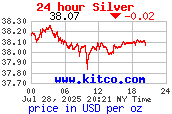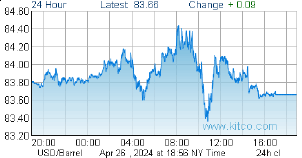TSX Venture Exchange and Gold
The Venture continues to follow a predictable path, testing exceptionally strong support in an ideal “accumulation zone” in advance of what the technical picture is showing will be a very robust third quarter. The Index fell 11 points last week to close at 1012, but held above 1000 where superb Fib. and chart support are limiting any pullbacks within this confirmed primary uptrend.
What’s interesting about this updated 6-month daily chart from John is the bullish “W” that has formed in the RSI(14) just below the 50% level – this is typically a highly reliable near-term reversal pattern, especially when it appears just after a successful test of strong technical support. This is also a repeat of what occurred in late May when an RSI “W” formed after the Index revisited the 970 level. What’s also notable is the pattern of higher Venture lows since early February.
The table is being set for a breakout this quarter above 1050, followed by an immediate acceleration of this bullish phase.
Venture 5-Year Weekly Chart
RSI(14) on this 5-year weekly chart (with Gold comparative) continues to follow an uptrend line which illustrates how the bulls are now firmly in control. In addition, you’ll note that the 50% RSI level has held as support throughout 2014 after serving as resistance since mid-2011 (major trend change). A modestly overbought condition in the RSI that emerged in March when the Index hit 1050 gradually unwound to that new support level.
The Q2 decline that took the Venture to massive support at 968 May 20 came on light volume, and accumulation (CMF indicator) remains steady and strong – the most extended period of healthy accumulation we’ve seen, actually, in a few years. This is a very bullish scenario, and includes a recent +DI/-DI crossover. Those who gave up on this market during the 8% retreat from 1050 made a profound miscalculation. Astute investors have a great chance to cash in big over the next few months in particular before the possibility of a fourth quarter correction.
The Seeds Have Been Planted (And Continue To Be Planted) For The Next Big Run In Gold Stocks
There’s no better cure for low prices than low prices. The great benefit of the collapse in Gold prices in 2013 is that it forced producers (at least most of them) to start to become much more lean in terms of their cost structures. Producers, big and small, have started to make hard decisions in terms of costs, projects, and rationalizing their their overall operations. Exploration budgets among both producers and juniors have also been cut sharply. In addition, government policies across much of the globe are making it more difficult (sometimes impossible) for mining companies to carry out exploration or put Gold (or other) deposits into production, thanks to the ignorance of many politicians and the impact of radical and vocal environmentalists (technology has made it easier for groups opposing mining projects to organize and disseminate information, even in remote areas around the globe). Ultimately, all of these factors are going to create a supply problem – think about it, where are the next major Gold deposits going to come from? On top of that, grades have fallen significantly just over the past decade.
Gold
What a week for Gold. After coming within just a few dollars of chart resistance at $1,350 at the end of the previous week, bullion got slammed right out of the gate Monday morning and that weakness extended into Tuesday, pulling the metal slightly below $1,300. A couple of mysterious, large sell orders (manipulation attempts?) hit the market, but Gold showed resilience. Particularly interesting is the fact that ETF investors rushed to buy as Gold dropped on Monday with assets in the SPDR Gold Trust jumping 8.7 tonnes to 808.7 tonnes – the largest daily gain since August 2011. Commerzbank analysts stated that “ETF investors clearly took advantage of the reduced price of Gold as an attractive opportunity to buy.” Bullion strengthened as the week progressed, aided obviously by rising geopolitical tensions including, of course, the shooting down of a Malaysian airliner above Ukraine by Russian-supported rebels.
A headline in today’s National Post said so much in so few words:
“Ukraine, Iraq, Syria, Gaza – Barack Obama, Where Are You When The World Is In Trouble?”
“Obama,” Adrian Humphreys wrote, “is increasingly facing questions on whether the American President is failing on the global stage as restive corners of the world threaten to implode.”
A United States withdrawing from the world stage – as it has during the Obama presidency – doesn’t make the world a safer place. In fact, just the opposite is true. As investors, one of the big “themes” we’ll have to deal with through the remainder of Obama’s term is an increasingly dangerous world with no Ronald Reagan or Margaret Thatcher to keep evil in check. At the very least, these global wildfires will put a floor under the price of Gold, and could in fact trigger an unexpectedly big move to the upside.
Technically, Gold broke below a symmetrical triangle in late May and then recovered immediately with a very powerful June – that kind of action should have bears concerned, especially since June traditionally has been Gold’s worst month of the year.
Solid support for bullion exists from the $1,280’s to $1,300 while a band of important resistance stretches from $1,320 to $1,330. If Gold can sustain a move above $1,330, look out.
For the week, bullion closed $28 lower at $1,311.

Silver fell 56 cents last week to finish at $20.89. Copper lost 8 pennies to $3.17. Crude Oil gained $2.30 a barrel to $103.13 while the U.S. Dollar Index added one-third of a point to 80.50.
The “Big Picture” View Of Gold
As Frank Holmes so effectively illustrates at www.usfunds.com, the long-term bull market in Gold has been driven by both the Fear Trade and the Love Trade. The transfer of wealth from west to east, and the accumulation of wealth particularly in China and India, has had a huge impact on bullion. Despite Gold’s largest annual drop in three decades in 2013, the fundamental long-term case for the metal remains solidly intact – currency instability and an overall lack of confidence in fiat currencies, governments and world leaders in general, an environment of historically low interest rates, a Fed balance sheet now at $4 trillion and still expanding, money supply growth around the globe, massive government debt from the United States to Europe, central bank buying, flat mine supply, physical demand (especially from China), emerging market growth, geopolitical unrest and conflicts…the list goes on. However, deflationary concerns around the globe and the prospect of Fed tapering had a lot to do with Gold’s plunge during the spring of 2013 below the technically and psychologically important $1,500 level, along with the strong performance of equities which drew “momentum traders” away from bullion. The June 2013 low of $1,179 was likely the bottom for Gold. Extreme levels of bearishness emerged in the metal last year. With the long-term bull market remaining intact, we expect new all-time highs in Gold as the decade progresses. Inflationary pressures should eventually kick in around the globe after years of ultra-loose monetary policy.
 BullMarketRun.ca
BullMarketRun.ca










the coil in gold broke to the downside … first break is typically false… we continue to be hopeful… golds ascent is our only hope Luke:)
Comment by Jeremy — July 20, 2014 @ 4:26 am
As long as JPMorgan et al (the crooks) are in control Gold and Silver prices are not going anywhere: Below is from Ed Steer at Casey Research:
Well, the Commitment of Traders Report for positions held at the close of Comex trading on Tuesday, July 15 was certainly not what I had hoped for, at least in silver.
The Commercial net short position in silver increased again, this time by 678 contracts, or 3.4 million ounces. The Commercial net short position now sits at 293.5 million troy ounces. The Big 4 trader’s short holdings [read JPMorgan] increased by around 1,200 contracts—and Ted Butler pegs JPMorgan’s short-side corner in the Comex silver market at about 19,000 contracts, or 95 million troy ounces. The ‘5 through 8’ largest short holders covered about 3,000 contracts of their short position during the reporting week.
In gold, the Commercial net short position actually improved by 9,097 contracts, or 909,700 troy ounces. The Commercial net short position in gold has obviously declined by that amount—and is down to 15.69 million troy ounces, which is still a horrendously large number.
The 8 largest short holders added 1,000 contracts to their short positions—and Ted says that JPMorgan sold another 3,000 contracts during the reporting week—and their long-side corner in the Comex gold market continues to shrink, and is now down to 2.2 million troy ounces, or 22,000 Comex contracts.
Ted said—and I agree—that probably not all of the decline on Monday and Tuesday was reported to the CFTC in a timely manner, so hopefully there’s some spill-over into next Friday’s Report. If that doesn’t prove to be the case however, it’s a given that next Friday’s COT Report will be even uglier than even I imagined it might be, because in my comments in The Wrap yesterday, I stated that JPMorgan et al threw everything they had at that spike in gold and silver prices in New York Thursday morning. That data alone should be enough to curl your hair.
Of course we have two more reporting days between now and the Tuesday cut-off—and anything can happen between now and then—but as it stands at the moment, the next COT will be pretty horrific, because almost the entire technical fund short positions in both metals are still in place, plus there will be more to add. This does not bode well for gold and silver prices somewhere down the road.
Comment by Greg — July 20, 2014 @ 3:44 pm